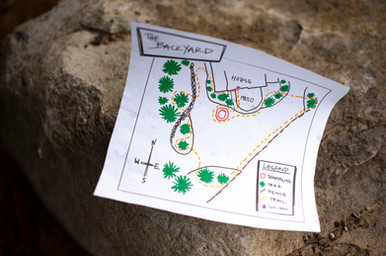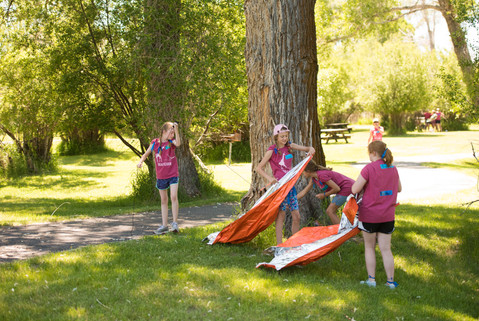Gather the kids and have fun! With so many summer camp activities, we hope you find something for everyone in the family. Skim through the topics, watch video tutorials, expand Micro Ventures, and print the free downloadable PDF worksheets.
Growth and spending time outdoors looks different for all SheJumpers–from putting on skis for the first time to hiking your local trails to your first mountain biking class to summiting Mt. Rainier–we create a supportive, safe, accessible, inspiring community to nurture transformation.
Now that you have your 2020 SheJumps Summer Camp Kit, it’s time to select the curriculum.

SheJumps Summer Camp resources
We've created a series of content to help prepare your at-home SheJumps Summer Camp.
SheJumps DIY Summer Camp: Activities Galore! (below)
SheJumps DIY Summer Camp: Customize Tie-Dye Shirts and Crafts
10 Essentials
ACTIVITY: Micro Ventures: 10 Essentials
As you’re preparing for your adventure, don’t forget to bring the essentials! Create a habit of bringing these essentials on all your trips. Lay out the gear on a table or blanket and pack a backpack to get ready for the trail. Depending on the audience, maybe sprinkle a few things now on the list for a little added complexity.
Navigation
Sun protection
Insulation
Illumination
First-aid supplies
Fire
Repair kit and tools
Nutrition
Hydration
Emergency shelter
Leave No Trace
Leave no trace practices were created to minimize impact to outdoor spaces. The seven principles are known to be outdoor ethics. Learning from a young age creates a habit of making the best decisions when you’re in the wilderness.
The saying, “Pack it in, pack it out” is common outdoor lingo. What does it mean? If you’re packing in food to eat while on the trail, then pack out the wrappers and leave nothing behind. We’ll go over how this includes going to the bathroom when a toilet isn’t available.
Plan ahead and prepare
Travel and camp on durable surface
Dispose of waste properly
Leave what you find
Minimize campfire impacts
Respect wildlife
Be considerate of other visitors

Learn all the recommended guidelines in detail on Leave No Trace website.
When you have to go, you have to go…
The improper disposal of human waste can contaminate water sources, spread diseases, and it’s just plain gross to come across while you’re on the trail or camping. There are many reasons why this topic can be intimidating from knowing what the rules are to finding the right place to go. Turning this into a game is a fun way to make this approachable for everyone in your group.
Learn the best practices on how to pee and poop in the video tutorial.
Navigation
ACTIVITY: Micro Ventures: How to Make a Compass
ACTIVITY: Micro Ventures: Map Making + Trail Hunts
ACTIVITY: Micro Ventures: Make a Topo Map
Combine a map with a compass and you have a powerful tool in the wilderness. Teaching kids the basic principles of how maps and compasses work together can evolve over time. We’re here to get you started.
First, Learn how magnetic poles work by making your own compass.
Second, Create your own trail map for a hands on experience on map basics, like reading and defining elements of a map.
Third, after you have basic map making and reading down, add the complexity of understanding topographic maps (or how contour lines give a visual representation of the terrain). Make your own topographic map.
First Aid
CHECKLIST: Simple First Aid Kit
CHECKLIST: Full First Aid Kit
Build your own First-Aid kit at home by using the checklists as a guide. Practice first-aid techniques when you’re close to home, so if something happens in the wilderness, you know what to do.
SheJumps Southeast Regional Director, Kelly Drewnowski, demonstrates some first-aid solutions.
VIDEO: How to make a quick splint with SheJumps Junior Ski Patrol.
VIDEO: You discover someone on the trail with a hurt arm, Here’s how to make a sling.
Rescue Communications
ACTIVITY: Micro Ventures: Signaling for Help!
Wilderness first-aid can only go so far. If your group or someone on the trail experiences an emergency, consider calling for help. Though the rescue radio communications guide focuses on two-way radios, knowing how the information on the incident when you call for help makes all the difference when the local search and rescue teams are dispatched. Learn and remember the S.A.I.L.E.R. acronym.
Signaling for Help! If you don’t have access to cellphone service, knowing the tools and ways to signal for help can make all the difference.
Shelter Building
ACTIVITY: Micro Ventures: How to Build a Shelter
If you’re in a scenario where you need to spend a few hours or the night outside, knowing the basic shelter building techniques will help you identify the best places to start. Shelter building takes creativity and learning how to use what’s around you will go a long way for keeping you dry and warm.
Survive Outdoors Longer (S.O.L.) creates best-in class survival shelters, fire starters, kits, and other outdoor tools that prepare you to expect the unexpected and make the most of your time outdoors. Providing quick, simple, and reliable solutions is the backbone of the brand, which is why all our products are designed for durability and ease of use. Learn more at www.surviveoutdoorslonger.com.
Plant Identification + Nature Data Hunt
The challenge of identifying plants is fun for the whole family. Understanding what’s growing in your yard or region makes fun games, not only at camp but on the trail as well. Purchasing a book for your region as a guide or downloading the iNaturalist app for your phone allows you to learn and catalog the plants to retain what they are and how to identify them.
Arts and Crafts
ACTIVITY: Gratitude Flags
ACTIVITY: Topographic Girafficorn Coloring Sheet
Add some color and flair to your basecamp and camp kit. Start by printing, coloring, and hanging girafficorn flags around camp to decorate. Take your Camper shirt or a white cotton shirt and add a tie-dye station or grab some fabric markers and color the SheJumps trucker hat. Need a little more girafficorn magic? Topographic girafficorn coloring sheet pairs nicely with reading a topographic map activity.
Now, it’s time to customize your summer camp by tie-dying your camp shirt and coloring your trucker hat. Get creative (and COLORFUL)!



















































Comments